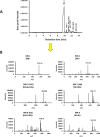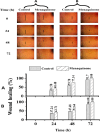Vitamin K (Menaquinone) from marine Kocuria sp. RAM1: optimization, characterization and potential in vitro biological activities
- PMID: 40483419
- PMCID: PMC12145650
- DOI: 10.1186/s12934-025-02751-8
Vitamin K (Menaquinone) from marine Kocuria sp. RAM1: optimization, characterization and potential in vitro biological activities
Abstract
Background: Menaquinone (MK), which is also known as vitamin K2, is a kind of lipoquinone that, unlike humans, is biosynthesized in bacteria through a series of steps as a necessary component of their respiratory chain for electron transport among various components of the bacterial cell membrane. MKs are receiving increasing attention as they play several essential biological roles in humans.
Results: In this study, MK was obtained from Kocuria sp. RAM1, characterized using UV absorbance, and validated using nuclear magnetic resonance spectroscopy (NMR) and liquid chromatography-electrospray ionization-quadrupole time-of-flight mass spectrometry (LC-ESI-QTOF-MS). The chemical characterization revealed a total of six MK analogues that were identified and confirmed as MK-1, MK-3, MK-5 (H2), MK-7 (H6), MK-8 (H2), and MK-9. Subsequent to the execution of a significant optimization model, a total KMs of 394.69 µg/ml was obtained, with the MK-1 analog being the dominant one. The antibacterial, anti-inflammatory, antioxidant, anticancer, antidiabetic, and wound-healing activities of MKs were evaluated in vitro. As a result, we discovered that MKs have promising findings on the tested in vitro activities.
Conclusions: Our study was made to evaluate MKs obtained from the Red Sea Kocuria sp. RAM1 to emphasize their significant role in different biological applications. Therefore, from a therapeutic and medicinal perspective, the extracted MKs are interesting for additional in vivo studies.
Keywords: Kocuria; Anti-inflammatory; Anticancer; Antidiabetic; Antimicrobial; Antioxidant; Menaquinone; Wound healing.
© 2025. The Author(s).
Conflict of interest statement
Declarations. Consent for publication: The authors declare that they know the content of this manuscript and have agreed to submit it to “Microbial Cell Factories”. Competing interests: The authors declare no competing interests.
Figures







Similar articles
-
Optimization and multiple in vitro activity potentials of carotenoids from marine Kocuria sp. RAM1.Sci Rep. 2022 Oct 28;12(1):18203. doi: 10.1038/s41598-022-22897-4. Sci Rep. 2022. PMID: 36307503 Free PMC article.
-
Characterization of MK₈(H₂) from Rhodococcus sp. B7740 and Its Potential Antiglycation Capacity Measurements.Mar Drugs. 2018 Oct 18;16(10):391. doi: 10.3390/md16100391. Mar Drugs. 2018. PMID: 30340371 Free PMC article.
-
Structure-activity relationships in the conversion of vitamin K analogues into menaquinone-4. Substrates essential to the synthesis of menaquinone-4 in cultured human cell lines.Bioorg Med Chem. 2010 May 1;18(9):3116-24. doi: 10.1016/j.bmc.2010.03.035. Epub 2010 Mar 19. Bioorg Med Chem. 2010. PMID: 20378364
-
Innovative Pyrazole Hybrids: A New Era in Drug Discovery and Synthesis.Chem Biodivers. 2025 Apr;22(4):e202402370. doi: 10.1002/cbdv.202402370. Epub 2024 Dec 23. Chem Biodivers. 2025. PMID: 39613478 Review.
-
Recent trends in the pharmacological activity of isoprenyl phenolics.Curr Med Chem. 2013;20(2):272-9. doi: 10.2174/092986713804806676. Curr Med Chem. 2013. PMID: 23244581 Review.
References
-
- Nobel Prize for Physiology and Medicine for 1943: Profs. H. Dam and E. A. Doisy. Nature. 1944; 154: 602. 10.1038/154602c0
-
- Dam H, Glavind J. Alimentary exudative diathesis, a consequence of E-avitaminosis. Nature. 1939;143:810–1. 10.1038/143810a0.
-
- Borjigin T, Feng J, Schmitt M, Zhu D, Morlet-Savary F, Xiao P, Lalevée J. Photoinitiators from bio-sourced naphthoquinone–the application of naphthoquinone-based vitamins K1 and K3 in free radical photopolymerization. Green Chem. 2024;26:277–86. 10.1039/d3gc03551d.
MeSH terms
Substances
LinkOut - more resources
Full Text Sources
Medical
Research Materials

